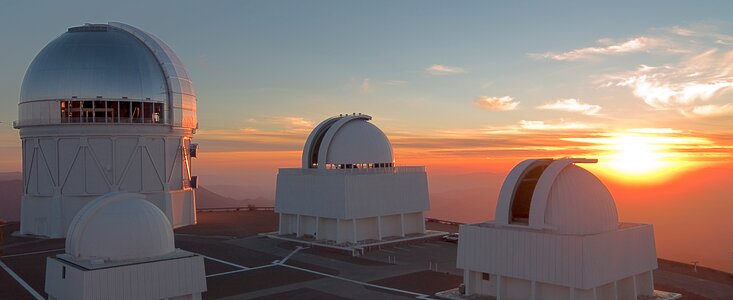ann18004-es — Anuncio
Equipos de Científicos Seleccionados para Observar el Eclipse Solar 2019 en CTIO
18 Octubre 2018
El 2 de julio de 2019 será un día muy especial en Sudamérica. En ese día, un eclipse total viajará de oeste a este a través del continente y, en un espectacular golpe de suerte astronómica, pasará directamente sobre el Observatorio Interamericano Cerro Tololo en Chile de la Fundación Nacional de Ciencia, uno de los sitios de astronomía más famosos del mundo. Cerro Tololo es un complejo de telescopios e instrumentos astronómicos ubicados a una altura de 2200 metros sobre el nivel del mar y es parte del Observatorio Nacional de Astronomía Óptica (NOAO) de Estados Unidos.
Los experimentos científicos realizados durante un eclipse solar aportandatos raros y valiosos para nuestra comprensión del Sol y su corona. Dado el paso fortuito del camino del eclipse, AURA decidió abrir el sitio de Cerro Tololo para eclipsar a los astrónomos de todo el mundo a través de una competencia juzgada por expertos en física solar del Observatorio Nacional Solar de Estados Unidos. Equipos internacionales de científicos solicitaron espacio en la montaña y ahora, cinco equipos de primera categoría han obtenido acceso a este fantástico lugar para estudiar el eclipse total. Cada propuesta fue revisada por su originalidad científica, su viabilidad técnica dada la ubicación remota y el clima invernal, y el impacto que la investigación tendrá a nivel local o internacional.
Los equipos ganadores han recibido alojamiento en la cumbre, una plataforma de observación en la que configurar su experimento, conexión a Internet y electricidad. El alto punto de observación y la atmósfera reducida crearán excelentes condiciones para ver la tenue corona solar.
Los equipos ganadores son:
- Williams College, Dr. Jay Pasachoff y su equipo tomarán imágenes de la corona del Sol utilizando una técnica que se ha utilizado durante los eclipses durante más de una década. El Dr. Pasachoff ha sido testigo de 70 eclipses totales y se centrará en las observaciones que informarán las predicciones del próximo ciclo solar.
- La Dra. Shadia Habbal y sus “Sherpas de viento solar” de la Universidad de Hawai utilizarán técnicas espectroscópicas para descifrar la composición química, la temperatura, la densidad, los movimientos no térmicos y las salidas de los diferentes componentes del plasma coronal, así como también probar estructuras de temperatura inusual alrededor de los filamentos del Sol.
- Un equipo del Observatorio de Gran Altitud de UCAR, dirigido por el Investigador Principal, el Dr. Paul Bryans. El equipo del Dr. Bryans analizará el campo magnético del Sol utilizando imágenes polarimétricas de la corona del Sol en luz infrarroja cercana. Este proyecto complementará las observaciones AIR-Spec financiadas por NSF que medirán simultáneamente los espectros desde una plataforma aerotransportada.
- El Dr. Miquel Serra-Ricart del Instituto de Astrofísica de Canarias (IAC) en Tenerife, España, utilizará el eclipse para investigar los cambios en la temperatura de la atmósfera de la Tierra y en particular de la ionosfera, a medida que la sombra pasa por encima. Entender cómo la respuesta de la ionosfera a los cambios en la entrada solar (que se elimina temporalmente durante un eclipse) tiene un gran valor para las predicciones del clima espacial.
- El Dr. Yoichiro Hanaoka, del Observatorio de Ciencias Solares del Observatorio Astronómico Nacional de Japón, llevará a cabo un esfuerzo para probar la corona cercana al Sol, que es una región de la atmósfera solar que no está bien cubierta por instrumentos espaciales. Combinar sus esfuerzos con otros dispersos en el camino de la totalidad aumentará la duración de la observación más allá de los pocos minutos de la totalidad en cualquier lugar.
- Además de sus objetivos científicos, cada equipo ha delineado un plan de divulgación que involucra la participación de estudiantes chilenos y extranjeros, astrónomos aficionados y el público en general en la maravillosa experiencia de persecución del eclipse. Una combinación de equipos de habla inglesa y española estará bien posicionada para que los jóvenes locales se sientan entusiasmados con esto y con los eclipses futuros, además de darles a algunos de ellos la oportunidad de participar realmente en la observación del eclipse.
La Asociación de Universidades para la Investigación en Astronomía (AURA) es un consorcio internacional de universidades e instituciones sin fines de lucro que operan en instalaciones de astronomía de clase mundial, como el Observatorio Nacional Solar de Estados Unidos, el Observatorio Nacional de Astronomía Óptica de EEUU, el Observatorio Gemini, el Gran Telescopio de Exploración Sinóptica (LSST por sus siglas en inglés), y el Instituto de Ciencia del Telescopio Espacial. En Chile, AURA administra y opera los telescopios de Cerro Tololo, Gemini Sur, SOAR y el futuro LSST bajo un acuerdo de cooperación con la Fundación Nacional de Ciencia de los Estados Unidos.
Enlaces
Ver la noticia del 18 de Octubre en: https://www.aura-astronomy.org/news.

